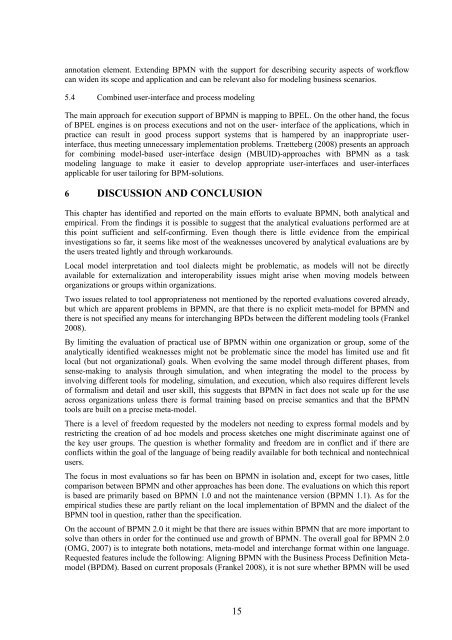Multi-channel provisioning of public services - Department of ...
Multi-channel provisioning of public services - Department of ...
Multi-channel provisioning of public services - Department of ...
You also want an ePaper? Increase the reach of your titles
YUMPU automatically turns print PDFs into web optimized ePapers that Google loves.
annotation element. Extending BPMN with the support for describing security aspects <strong>of</strong> workflow<br />
can widen its scope and application and can be relevant also for modeling business scenarios.<br />
5.4 Combined user-interface and process modeling<br />
The main approach for execution support <strong>of</strong> BPMN is mapping to BPEL. On the other hand, the focus<br />
<strong>of</strong> BPEL engines is on process executions and not on the user- interface <strong>of</strong> the applications, which in<br />
practice can result in good process support systems that is hampered by an inappropriate userinterface,<br />
thus meeting unnecessary implementation problems. Trætteberg (2008) presents an approach<br />
for combining model-based user-interface design (MBUID)-approaches with BPMN as a task<br />
modeling language to make it easier to develop appropriate user-interfaces and user-interfaces<br />
applicable for user tailoring for BPM-solutions.<br />
6 DISCUSSION AND CONCLUSION<br />
This chapter has identified and reported on the main efforts to evaluate BPMN, both analytical and<br />
empirical. From the findings it is possible to suggest that the analytical evaluations performed are at<br />
this point sufficient and self-confirming. Even though there is little evidence from the empirical<br />
investigations so far, it seems like most <strong>of</strong> the weaknesses uncovered by analytical evaluations are by<br />
the users treated lightly and through workarounds.<br />
Local model interpretation and tool dialects might be problematic, as models will not be directly<br />
available for externalization and interoperability issues might arise when moving models between<br />
organizations or groups within organizations.<br />
Two issues related to tool appropriateness not mentioned by the reported evaluations covered already,<br />
but which are apparent problems in BPMN, are that there is no explicit meta-model for BPMN and<br />
there is not specified any means for interchanging BPDs between the different modeling tools (Frankel<br />
2008).<br />
By limiting the evaluation <strong>of</strong> practical use <strong>of</strong> BPMN within one organization or group, some <strong>of</strong> the<br />
analytically identified weaknesses might not be problematic since the model has limited use and fit<br />
local (but not organizational) goals. When evolving the same model through different phases, from<br />
sense-making to analysis through simulation, and when integrating the model to the process by<br />
involving different tools for modeling, simulation, and execution, which also requires different levels<br />
<strong>of</strong> formalism and detail and user skill, this suggests that BPMN in fact does not scale up for the use<br />
across organizations unless there is formal training based on precise semantics and that the BPMN<br />
tools are built on a precise meta-model.<br />
There is a level <strong>of</strong> freedom requested by the modelers not needing to express formal models and by<br />
restricting the creation <strong>of</strong> ad hoc models and process sketches one might discriminate against one <strong>of</strong><br />
the key user groups. The question is whether formality and freedom are in conflict and if there are<br />
conflicts within the goal <strong>of</strong> the language <strong>of</strong> being readily available for both technical and nontechnical<br />
users.<br />
The focus in most evaluations so far has been on BPMN in isolation and, except for two cases, little<br />
comparison between BPMN and other approaches has been done. The evaluations on which this report<br />
is based are primarily based on BPMN 1.0 and not the maintenance version (BPMN 1.1). As for the<br />
empirical studies these are partly reliant on the local implementation <strong>of</strong> BPMN and the dialect <strong>of</strong> the<br />
BPMN tool in question, rather than the specification.<br />
On the account <strong>of</strong> BPMN 2.0 it might be that there are issues within BPMN that are more important to<br />
solve than others in order for the continued use and growth <strong>of</strong> BPMN. The overall goal for BPMN 2.0<br />
(OMG, 2007) is to integrate both notations, meta-model and interchange format within one language.<br />
Requested features include the following: Aligning BPMN with the Business Process Definition Metamodel<br />
(BPDM). Based on current proposals (Frankel 2008), it is not sure whether BPMN will be used<br />
15
















